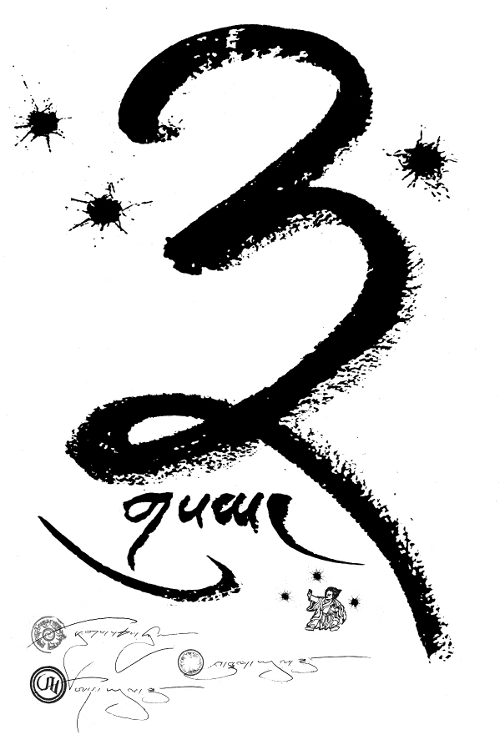
Sum (gSum)
three
The number three frequently occurs in Buddhist teachings. For example:
- Tsig-sum nèdék – Striking the Essence in Three Incisive Indications. These three are: Direct Introduction, Remaining Without Doubt, and Continuing in the State. These three incisive indications were the final essential indicative presentation describing the direct meaning of Dzogchen given by Garab Dorje (dGa’ rab rDo rJe).
- Könchog Sum (dKon mChog gSum) – the three jewels and the source of refuge at the outer level, sutra. They are: sang-gyé (sangs gyas) – the Buddha or Awakened One; chö (chos) – the Dharma or body of teachings; and gendün (dGe ’dun) – the Sangha or community of practitioners. Sang-gyé is the source of chö and those whose minds are turned towards chö are gendün.
- Ma Za Dor Sum (ma za rDo gSum) – the three protectors of the Nyingma tradition. These three are: Mamo Ekajati (man mo e mKha dza ’ti), Za Rahula (Za Ra hu la), and Dorje Legpa (Dam chan rDo rJe Legs pa).
- Ku sum (sKu gSum) – the three Spheres of Being. These are: the Sphere of Unconditioned Potentiality, the Sphere of Visionary Appearances and the Sphere of Realised Manifestation – chö-ku (chos sku), dharmakaya; Long-ku (longs sku), sambhogakaya; and Trül-ku (sprul sku), nirmanakaya.
- Gyüpa sum (khyad par gyi brGyud pa gSum) – the three special gTérma lineages of the Nyingma Tradition. These are: Kabab Lung-ten gi gyüdpa (bKa’ babs lung bsTan gyi brGyud pa) – prophetic mandate lineage; Mönlam dBang-kur gi gyüdpa (sMon lam dBang bsKur gyi brGyud pa) – lineage of empowerment through aspiration; and Khandro Tad-gya gi gyüdpa (mKha’ ’gro gTad rGya gyi brGyud pa) – Mind mandate lineage of the khandros.
- Nyipa sum (nyes pa gSum): the wind (rLung), bile (mKhris pa), and phlegm (bad kan) of Tibetan Medicine (gSo ba rig pa). The long-term causative factors of Nyipa sum are understood to be the nyon mong-pa dug sum (nyon mongs pa dug gsum) – the three primary misconceptions of attraction, aversion and indifference.
- Thegpa sum (theg pa gsum) – the three vehicles of Hinayana, Mahayana and Vajrayana.
- Tsa sum (rTsa gSum) – the three roots of practice: Lama, yidam, and khandro/pawo. The inner refuge at the level of outer tantra.
- Dé sum (sDe gSum) – the three series of Dzogchen: sem-dé (sems sDe), long-dé (kLong sDe) and men-ngak-dé (men ngag sDe). Sem-dé is the series of the Nature of Mind and has the greatest proportion of explanation. Long-dé has less explanation and is the series of Space. Men-ngak-dé has no explanation and is the series of Implicit Instruction.
